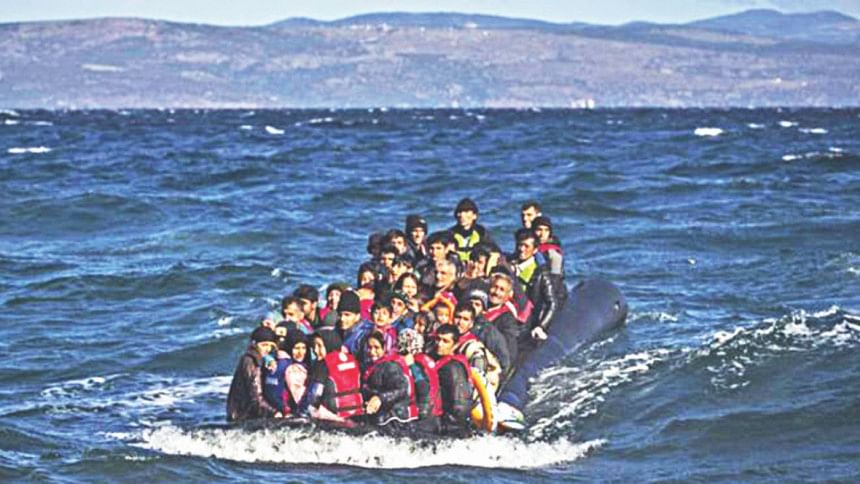Labour Migration: Deadly desperation

Jumman Hawlader had turned 19 when his family began to expect some contribution from him. And a year later, he got lost in the Mediterranean on way to Europe.
With all dreams shattered, they have now plunged into a cycle of poverty.
“I just want back my son,” said his father Harun Hawlader, 48, as he lamented the drowning of Jumman along with some 70 others, including 40 Bangladeshis, in the sea on May 9.
Lured by manpower brokers, Harun of Naria in Shariatpur sold 66 decimals of cropland to arrange Tk 4.5 lakh for Jumman’s trip to Libya on June 5 last year.
He knew little of Bangladesh’s ban on sending workers there because of the civil war in the North African country.
The family sold another 15 decimals after seven months as Jumman now wanted to go to Italy from Libya.
“We have lost both my brother and money,” said Sonia Akter, Jumman’s elder sister, explaining the financial crisis of the family that now has only its 24-decimal homestead.
Jumman had dropped out of school as he failed in class IX in 2017.
Now his younger brother Ayon Hawlader, 14, has to leave study and he might start selling labour along with his father to eke out a living.
THE MIGRATION CYCLE
Death of Bangladeshi youths in such tragic incidents is nothing new. In a major boat accident in the sea, 24 Bangladeshis died in August 2015.
According to the UN Migration Agency, as many as 443 migrants either died or went missing in the Mediterranean while trying to reach Europe as of May 8 this year. The figure was 2,299 in 2018 and 3,139 in 2017.
Apart from human trafficking that leads loss of young lives, trafficking gangs, fraudulence and exploitations continue to plague the labour migration sector.
High recruitment cost, fraudulence in recruitment and low pays are some of the very common problems faced by the migrants, said Prof Tasneem Siddiqui, chair of Refugee and Migratory Movements Research Unit (RMMRU) at Dhaka University.
“The financial condition of a large section of them does not improve at all through the migration cycle. Many are pushed into poverty,” she told The Daily Star.
Tasneem Siddiqui said their study in 2017 found 19 percent overseas jobseekers are defrauded in Bangladesh and cannot go abroad despite paying money to the middlemen.
And 32 percent migrants face various forms of exploitation -- joblessness, irregular wages or non-payment of wages abroad. Many of them return home a few months after going abroad, she said.
RMMRU studies in 1999 found 14 percent migrant workers saw deterioration of their financial condition, 64 percent saw improvement, while the condition of 22 percent migrants remained similar.
Sadly, the proportion of migrants who saw their financial condition deteriorate was now higher than that in 1999, Taneem said.
She cited a RMMRU study that found annual per capita remittance from the Bangladeshi male migrants fell by 11 percent in 2017 compared to that in 2014.
The annual remittance from male migrants, which was Tk 218,812 each in 2014, came down to Tk 193,885. If it is adjusted to inflation, the drops in remittance would be 26 percent, she said.
The remittance (which was $15 billion in 2018) sent by about one crore migrants annually is visible, but a huge amount of money that’s laundered out of Bangladesh every year never comes to public domain, said Transparency International Bangladesh (TIB) Executive Director Dr Iftekharuzzaman.
MALPRACTICES AND CORRUPTION
A TIB study in 2016 found that more than $2 billion was laundered out of Bangladesh to six major labour-recruiting countries -- Saudi Arabia, Qatar, UAE, Oman, Singapore and Malaysia -- to illegally purchase work visas. The amount could be bigger if all the other labour destination countries are considered.
Malpractices and corruption in labour migration process both in Bangladesh and destination countries are costing the Bangladeshi migrant workers at least 3-4 times their peers in other South and Southeast Asian countries, said Iftekharuzzaman.
Yet Bangladeshi migrants are often comparatively ill-paid than workers from other countries.
“As a result, it takes them at least several years of hard work to recover the high investment they make, in most cases by selling property or by borrowing at high interest,” he told The Daily Star.
“While migrant remittance is the second largest source of foreign exchange for the economy, the economic condition of workers themselves and their families transforms in real terms only to a limited level at best.”
Tasneem Siddiqui said the authorities seem nonchalant in addressing those malpractices faced by the sector.
“If our government doesn’t take strong actions against the illegal activities by the recruitment agents and brokers at home and abroad, the situation is bound to further worsen,” he added.
Bangladeshis comprise a notable portion of the migrants taking risky sea journeys. Apart from Libya, another route of human trafficking or smuggling to Europe is through Iran. Within Asia, two prominent routes to Malaysia are Indonesia and Thailand.
Shah Alam, deputy inspector general at the CID, who dealt a number of human trafficking cases of Iran, said there are hundreds of incidents where criminal gangs lured Bangladeshi workers in the countries like UAE, Oman, Qatar, Iraq and Bahrain promising safe journey to Europe.
However, they took them to Iran, held them hostage, tortured and then collected ransom before putting them on boats.
In 2013, some 2000 Bangladeshis became victims of trafficking and each of them on average had to pay Tk 7 lakh to the trafficking gangs, he said.


 For all latest news, follow The Daily Star's Google News channel.
For all latest news, follow The Daily Star's Google News channel. 








Comments